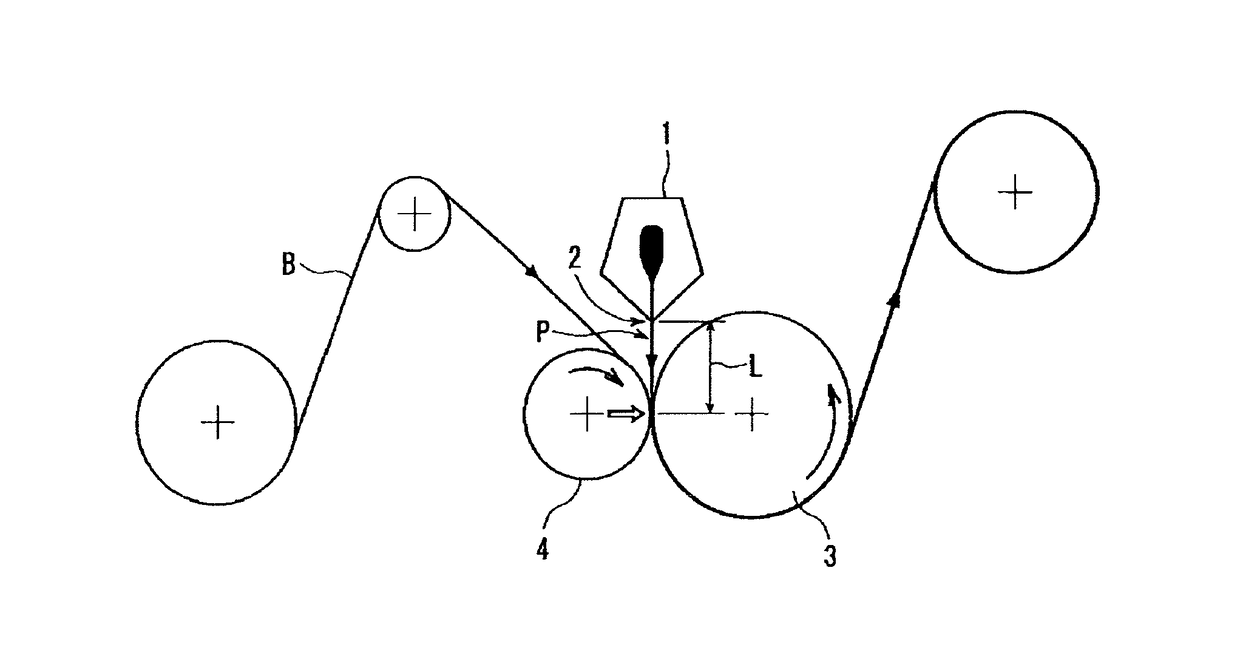Heat-sealable laminate and method for producing same
a technology of heat sealing and laminate, which is applied in the field of heat sealing laminate, can solve the problems of difficult to obtain stable film-forming properties, limited use of polyolefin, and insufficient quality of polyolefin, and achieves the effects of easy formation, good economic benefits, and convenient availability
- Summary
- Abstract
- Description
- Claims
- Application Information
AI Technical Summary
Benefits of technology
Problems solved by technology
Method used
Image
Examples
example 1
[0060]An extrusion laminator was adjusted so that an air gap with respect to a die (width: about 110 cm) having a lip opening width adjusted to 0.8 mm (the air gap=the distance from the lip opening of a T-die to a cup stock base paper to be coated) would be 10 cm. Homopolyethylene terephthalate at an extrusion temperature of 300° C. was extruded from the die at an extrusion pressure of 6.0 MPa, and coated on a cup stock base paper (corona discharge treated; basis weight 320 g / m2). The homopolyethylene terephthalate used in Examples 1 to 14 and Comparative Examples 1 to 5 was one having an inherent viscosity of 0.83 dL / g and a melting point of 250° C. (NOVAPEX BK6180, produced by Mitsubishi Chemical Corp.).
[0061]The coating thickness of the homo-PET was 25 μm, and the coating line speed was 65 m / min. Simultaneously with the coating of the base paper, the coated base paper was passed between a chill roll (surface temperature: 22° C.) and a rubber roll to complete a laminate. In connec...
example 2
[0062]The same procedure as in Example 1 was performed, except that the air gap was set at 5 cm. The state of the extruded laminate was evaluated. The results are shown in Table 1.
example 3
[0063]The same procedure as in Example 1 was performed, except that the air gap was set at 15 cm. The state of the extruded laminate was evaluated. The results are shown in Table 1.
PUM
| Property | Measurement | Unit |
|---|---|---|
| thickness | aaaaa | aaaaa |
| thickness | aaaaa | aaaaa |
| temperature | aaaaa | aaaaa |
Abstract
Description
Claims
Application Information
 Login to View More
Login to View More - R&D
- Intellectual Property
- Life Sciences
- Materials
- Tech Scout
- Unparalleled Data Quality
- Higher Quality Content
- 60% Fewer Hallucinations
Browse by: Latest US Patents, China's latest patents, Technical Efficacy Thesaurus, Application Domain, Technology Topic, Popular Technical Reports.
© 2025 PatSnap. All rights reserved.Legal|Privacy policy|Modern Slavery Act Transparency Statement|Sitemap|About US| Contact US: help@patsnap.com


